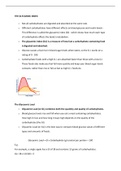Summary
Summary Glycemic Index vs. Load , Food additives and Consumer issues related to the impact of the use of food on the natural and economic environment
- Course
- Institution
This document contains information regarding the Grade 12 Food and Nutrition Chapter, which have been written meticulously according to the updated IEB SAGs for Consumer Studies for 2022/2023 etc. These summaries include the differentiation between glyaemic index and load as well as food additives ...
[Show more]



